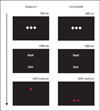Attention to threats and combat-related posttraumatic stress symptoms: prospective associations and moderation by the serotonin transporter gene
- PMID: 23407816
- PMCID: PMC4469781
- DOI: 10.1001/2013.jamapsychiatry.188
Attention to threats and combat-related posttraumatic stress symptoms: prospective associations and moderation by the serotonin transporter gene
Abstract
Importance: Combat places soldiers at risk for posttraumatic stress disorder (PTSD). The excessive rates of PTSD and other adjustment disorders in soldiers returning home make it imperative to identify risk and resilience factors that could be targeted by novel therapeutic treatments.
Objective: To investigate the interplay among attention to threat, combat exposure, and other risk factors for PTSD symptoms in soldiers deployed to combat.
Design and setting: Longitudinal prospective study of Israeli Defense Force infantry soldiers carried out in 2008 through 2010. Repeated measurements during a 1-year period included baseline and predeployment data collected in training camps and deployment data collected in the combat theater.
Participants: Infantry soldiers (1085 men; mean age, 18.8 years).
Main outcome measures: Postcombat PTSD symptoms. RESULTS Soldiers developed threat vigilance during combat deployment, particularly when they were exposed to high-intensity combat, as indicated by faster response times to targets appearing at the location of threat relative to neutral stimuli (P < .001). Threat-related attention bias also interacted with combat exposure to predict risk for PTSD (P < .05). Bias toward threat at recruitment (P < .001) and bias away from threat just before deployment (P < .05) predicted postcombat PTSD symptoms. Moreover, these threat-related attention associations with PTSD were moderated by genetic and environmental factors, including serotonin transporter (5-HTTLPR) genotype.
Conclusions and relevance: Combat exposure interacts with threat-related attention to place soldiers at risk for PTSD, and interactions with other risk factors account for considerable variance in PTSD vulnerability. Understanding these associations informs research on novel attention bias modification techniques and prevention of PTSD.
Conflict of interest statement
Figures



References
-
- McNally RJ. Progress and controversy in the study of posttraumatic stress disorder. Annu Rev Psychol. 2003;54:229–252. - PubMed
-
- Yehuda R, LeDoux J. Response variation following trauma: a translational neuroscience approach to understanding PTSD. Neuron. 2007;56(1):19–32. - PubMed
-
- Bar-Haim Y, Lamy D, Pergamin L, Bakermans-Kranenburg MJ, van IJzendoorn MH. Threat-related attentional bias in anxious and nonanxious individuals: a meta-analytic study. Psychol Bull. 2007;133(1):1–24. - PubMed
-
- MacLeod C, Mathews A, Tata P. Attentional bias in emotional disorders. J Ab-norm Psychol. 1986;95(1):15–20. - PubMed
-
- Wald I, Lubin G, Holoshitz Y, Muller D, Fruchter E, Pine DS, Charney DS, Bar-Haim Y. Battlefield-like stress following simulated combat and suppression of attention bias to threat. Psychol Med. 2011;41(4):699–707. - PubMed
Publication types
MeSH terms
Substances
Grants and funding
LinkOut - more resources
Full Text Sources
Other Literature Sources
Medical
Molecular Biology Databases

